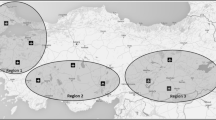Abstract
Unmanned Aerial Vehicles (UAVs) can provide significant contributions to information gathering in military missions. UAVs can be used to capture both full motion video and still imagery of specific target locations within the area of interest. In order to improve the effectiveness of a reconnaissance mission, it is important to visit the largest number of interesting target locations possible, taking into consideration operational constraints related to fuel usage, weather conditions and endurance of the UAV. We model this planning problem as the well-known orienteering problem, which is a generalization of the traveling salesman problem. Given the uncertainty in the military operational environment, robust planning solutions are required. Therefore, our model takes into account uncertainty in the fuel usage between targets, for instance due to weather conditions. We report results for using different uncertainty sets that specify the degree of uncertainty against which any feasible solution will be protected. We also compare the probability that a solution is feasible for the robust solutions on one hand and the solution found with average fuel usage on the other. These probabilities are assessed both by simulation and by derivation of problem specific theoretical bounds on the probability of constraint feasibility. In doing so, we show how the sustainability of a UAV mission can be significantly improved. Additionally, we suggest how the robust solution can be operationalized in a realistic setting, by complementing the robust tour with agility principles.

Similar content being viewed by others
References
Ben-Tal, A., & Nemirovski, A. (1997). Stable truss topology design via semidefinite programming. SIAM Journal on Control and Optimization, 7(4), 991–1016.
Ben-Tal, A., & Nemirovski, A. (1998). Robust convex optimization. Mathematics of Operations Research, 23(4), 769–805.
Ben-Tal, A., Ghaoui, L. E., & Nemirovski, A. (2009). Robust optimization. Princeton and Oxford: Princeton University Press.
Ben-Tal, A., den Hertog, D., & Vial, J. (2012). Deriving robust counterparts of nonlinear uncertain inequalities. Center discussion paper series no. 2012-053.
Bertsimas, D., & Sim, M. (2004). The price of robustness. Operations Research, 52(1), 35–53.
Bertuccelli, L., Alighanbari, M., & How, J. (2004). Robust planning for coupled cooperative UAV missions. In CDC 43rd IEEE conference on decision and control, 2004 (Vol. 14(4), pp. 5–19).
Chao, I., Golden, B., & Wasil, E. (1996). Theory and methodology: a fast and effective heuristic for the orienteering problem. European Journal of Operational Research, 88, 475–489.
El Ghaoui, L., & Lebret, H. (1997). Robust solution to least-squares problems with uncertain data. SIAM Journal on Matrix Analysis and Applications, 18, 1035–1064.
El Ghaoui, L., Oustry, F., & Lebret, H. (1998). Robust solutions to uncertain semidefinite programs. SIAM Journal on Optimization, 9, 33–52.
Feillet, D., Dejax, P., & Gendreau, M. (2005). Traveling salesman problems with profits: an overview. Transportation Science, 39, 188–205.
Fischetti, M., Salazar, J., & Toth, P. (1998). Solving orienteering problem through branch-and-cut. INFORMS Journal on Computing, 10, 133–148.
IBM (2009). IBM ILOG CPLEX V12.1 User Manual for CPLEX.
Kouvelis, P., & Yu, G. (1997). Robust discrete optimization and its applications. London: Kluwer Academic.
Laporte, G., & Martello, S. (1990). The selective traveling salesman problem. Discrete Applied Mathematics, 26, 193–207.
Miller, C., Tucker, A., & Zemlin, R. (1960). Integer programming formulations and travelling salesman problems. Journal of the ACM, 7, 326–329.
Mufalli, F., Batta, R., & Nagi, R. (2010). Simultaneous sensor selection and routing of unmanned aerial vehicles for complex mission plans. Working paper, Department of Industrial and Systems Engineering, University at Buffalo, State University of New, York.
Poggi, M., Viana, H., & Uchoa, E. (2010). The team orienteering problem: formulations and branch-cut and price. In 10th workshop on algorithmic approaches for transportation modelling, optimization, and systems (ATMOS10) (pp. 142–155).
Rockafellar, R. (1970). Convex analysis. Princeton: Princeton University Press.
Royset, J. O., & Reber, D. N. (2010). Optimized routing of unmanned aerial systems for the interdiction of improvised explosive devices. Military Operations Research, 3(4), 2917–2922.
Sammuelson, D. A. (2010). Changing the war with analytics. OR/MS Today 37, 30–35.
Soyster, A. (1973). Convex programming with set-inclusive constraints and applications to inexact linear programming. Operations Research, 21(5), 1154–1157.
Tsiligirides, T. (1984). Heuristic methods applied to orienteering. Journal of the Operational Research Society, 35, 797–809.
Vansteenwegen, P., Souffria, W. & van Oudheusden, D. (2011). The orienteering problem: a survey. European Journal of Operational Research, 209(1), 1–10.
Zaloga, S. (2008). Unmanned aerial vehicles: robotic air warfare 1917–2007. ???: Osprey Publishing.
Acknowledgements
In this paper we applied techniques from robust optimization, provided to us in an LNMB course by Prof. A. Ben-Tal and Prof. D. den Hertog. We sincerely thank Prof. A. Ben-Tal and Prof. D. den Hertog for sharing their insights on the applicability of these techniques to our UAV planning problem. Also, we thank the participants of the ORP3 conference for their remarks on a previous version of this research. Finally, we thank the anonymous referees for their valuable comments on previous versions of this paper.
Author information
Authors and Affiliations
Corresponding author
Rights and permissions
About this article
Cite this article
Evers, L., Dollevoet, T., Barros, A.I. et al. Robust UAV mission planning. Ann Oper Res 222, 293–315 (2014). https://doi.org/10.1007/s10479-012-1261-8
Published:
Issue Date:
DOI: https://doi.org/10.1007/s10479-012-1261-8




